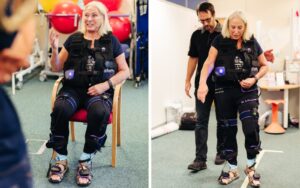
AI has the potential to make a real difference in the lives of people with paralysis and give them the chance to live full and independent lives.
By Mariana Meneses
Researchers at Northwell Health’s Feinstein Institutes have implanted microchips in a quadriplegic man’s brain, using AI to reconnect his brain to body and spinal cord. This new technology restored some of the man’s movement and sensations, marking it the first successful electronic neural bypass for lasting mobility outside the lab.
According to Medical Press, in August 2023, “this double neural bypass forms an electronic bridge that allows information to flow once again between the man’s paralyzed body and brain to restore movement and sensations in his hand with lasting gains in his arm and wrist outside of the laboratory.”
Double neural bypass: Man living with paralysis has feeling, lasting movement restored in arm & hand
Paralyzed from the chest down, Keith Thomas, 45, from New York, is the first human to use the technology.
On July 18, 2020, a diving accident caused him to suffer injury at the C4 and C5 level of the vertebrae in his spine, leaving him unable to move and feel from the chest down. “There was a time that I didn’t know if I was even going to live, or if I wanted to, frankly. And now, I can feel the touch of someone holding my hand. It’s overwhelming,” said Mr. Thomas.
“This is the first time the brain, body and spinal cord have been linked together electronically in a paralyzed human to restore lasting movement and sensation,” said Chad Bouton, who was the principal investigator in the clinical trial.
Over a hundred million people worldwide have some form of movement impairment or paralysis. These technologies offer hope for many of them, so it is important that they become widely available: not only to the wealthy, but also integrated into public health systems.
Brain-computer interface helps woman to communicate. Credit: Noah Berger.
Through AI breakthroughs, a 30-year-old woman named Ann who was previously paralyzed due to a brainstem stroke is now regaining her ability to communicate.
According to the University of California, Ann uses a brain-computer interface that translates her brain signals into facial expressions and text. This brain-computer interface (BCI) marks a significant advancement from her previous device that had very limited communication ability. Ann’s brainstem stroke resulted in severe paralysis, leaving her without control over her muscles, including those crucial for speech and even breathing.
After years of physical therapy, she achieved progress in moving her facial muscles, enabling laughter and tears. Now, Ann plays a vital role in collaborating with researchers at UC San Francisco and UC Berkeley to pioneer innovative brain-computer technology which aims to create a future where individuals with similar conditions can communicate more fluidly through digital avatars.
It is the first time that either speech or facial expressions have been synthesized from brain signals. The system can also decode these signals into text at nearly 80 words per minute, a vast improvement over the 14 words per minute that Ann’s previous communication device delivered.
Edward Chang, MD, chair of neurological surgery at UCSF, who has worked on the BCI technology for more than a decade, hopes this latest research breakthrough will lead to a system approved by the U.S. Federal Drug Administration that will enable speech from brain signals in the near future.

In the UK’s inaugural trial of AI-powered ‘NeuroSkin’ trousers, stroke survivor Julie Lloyd is regaining her ability to walk independently, heralding a breakthrough for stroke patients and their recovery.
According to BBC News, in August 2023, the “NeuroSkin” trousers stimulate paralyzed legs using electrodes controlled by artificial intelligence, and these new technologies are giving hope to the UK’s 1.3 million stroke survivors. The NeuroSkin trousers were developed by a Lyon-based firm called Kurage, and the developers have stated that the invention is already revolutionizing stroke care in France, but Ms. Lloyd is one of the first involved in the UK’s own trial.
Artificial intelligence is revolutionizing the way we treat and manage paralysis. From brain-computer interfaces that allow people to communicate and move again, to neural bypasses that restore feeling and movement, AI is giving hope to millions of people who have been told that they will never walk or talk again.
These technologies are still in their early stages, but they offer the potential to transform the lives of many people. With continued research and development reducing cost and increasing availability, AI has the potential to make a real difference in the lives of people with paralysis and give them the chance to live full and independent lives.
Interested in broadening your knowledge? Check out these other TQR articles:
- What If We Could Cure Cancer by Telling Cancer Cells to Get Better?
- Reversing the Ageing Process? New Discovery Points to The Body’s Relationship With Time
- New Understanding of How Cells Communicate May Supercharge Medical Advances
- Discovering the Human Code: the Most Complete Human Genome Ever Created
- CRISPR Technology: Editing the Genetic Code, From Plants to Humans



